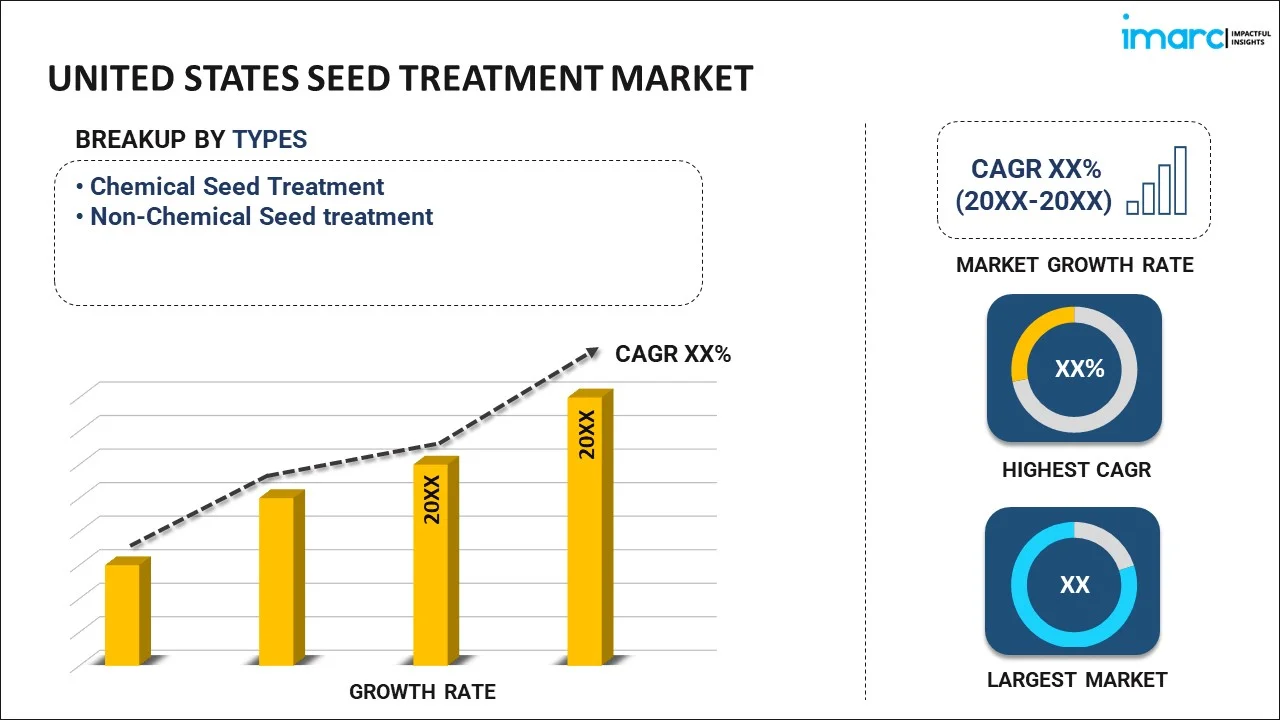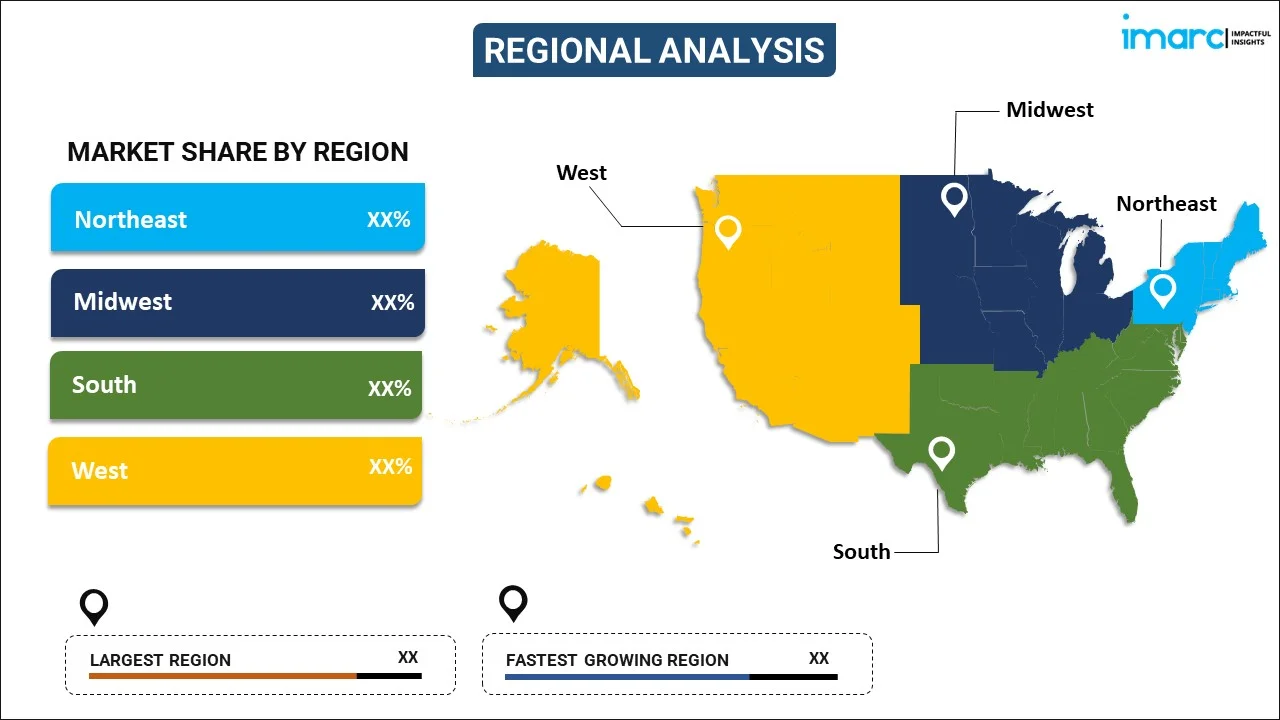
United States Seed Treatment Market Report by Type (Chemical Seed Treatment, Non-Chemical Seed treatment), Application Technique (Seed Coating, Seed Dressing, Seed Pelleting, and Others), Crop Type (Corn/Maize, Soybean, Wheat, Rice, Cotton, and Others), Function (Seed Protection, Seed Enhancement, and Others), and Region 2026-2034
Market Overview:
United States seed treatment market size is projected to exhibit a growth rate market size reached USD 2,455.1 Million in 2025. Looking forward, IMARC Group expects the market to reach USD 4,069.6 Million by 2034, exhibiting a growth rate (CAGR) of 5.78% during 2026-2034. The ongoing R&D in seed treatment technologies, which have led to innovations in formulations, application methods, and the development of new active ingredients, is driving the market.
|
Report Attribute
|
Key Statistics
|
|---|---|
|
Base Year
|
2025
|
|
Forecast Years
|
2026-2034
|
|
Historical Years
|
2020-2025
|
|
Market Size in 2025
|
USD 2,455.1 Million |
|
Market Forecast in 2034
|
USD 4,069.6 Million |
| Market Growth Rate 2026-2034 | 5.78% |
Access the full market insights report Request Sample
Seed treatment is a crucial agricultural practice aimed at enhancing the performance and protection of seeds before planting. This method involves the application of various treatments to seeds, such as fungicides, insecticides, and other protective agents. The primary goals of seed treatment are to safeguard seeds from pests, diseases, and environmental stressors, ultimately promoting better germination, seedling vigor, and crop establishment. By applying these treatments directly to the seeds, farmers can create a protective barrier that shields the emerging plant from potential threats in its early stages of development. Seed treatment contributes to improved crop yields, reduced dependence on chemical inputs during the growing season, and more sustainable agricultural practices. Additionally, it offers a targeted and efficient means of pest and disease management, minimizing the environmental impact associated with broad-spectrum pesticide applications. Overall, seed treatment plays a vital role in ensuring the success and resilience of crops from the very start of their growth cycle.
United States Seed Treatment Market Trends:
The seed treatment market in the United States is experiencing robust growth due to several interconnected factors. Firstly, the increasing regional population necessitates enhanced agricultural productivity, driving the demand for advanced seed treatment solutions. Consequently, the rising need for efficient pest control and disease management in crops has fueled the adoption of seed treatment technologies, creating a positive trajectory for market expansion. Moreover, climate change and unpredictable weather patterns have heightened the vulnerability of crops to various stresses. In response, farmers are increasingly turning to seed treatment as a proactive measure to safeguard their yields against environmental challenges. Additionally, advancements in biotechnology and genetic engineering have paved the way for innovative seed treatment formulations, further propelling market growth. Furthermore, the heightened awareness and emphasis on sustainable agricultural practices on account of the growing concern for environmental conservation and the desire to minimize the ecological impact of traditional farming methods is expected to drive the seed treatment market in the United States during the forecast period.
United States Seed Treatment Market Segmentation:
IMARC Group provides an analysis of the key trends in each segment of the market, along with forecasts at the country level for 2026-2034. Our report has categorized the market based on type, application technique, crop type, and function.
Type Insights:

To get detailed segment analysis of this market Request Sample
- Chemical Seed Treatment
- Non-Chemical Seed treatment
The report has provided a detailed breakup and analysis of the market based on the type. This includes chemical seed treatment and non-chemical seed treatment.
Application Technique Insights:
- Seed Coating
- Seed Dressing
- Seed Pelleting
- Others
A detailed breakup and analysis of the market based on application technique have also been provided in the report. This includes seed coating, seed dressing, seed pelleting, and others.
Crop Type Insights:
- Corn/Maize
- Soybean
- Wheat
- Rice
- Cotton
- Others
The report has provided a detailed breakup and analysis of the market based on the crop type. This includes corn/maize, soybean, wheat, rice, cotton, and others.
Function Insights:
- Seed Protection
- Seed Enhancement
- Others
A detailed breakup and analysis of the market based on function have also been provided in the report. This includes seed protection, seed enhancement, and others.
Regional Insights:

To get detailed regional analysis of this market Request Sample
- Northeast
- Midwest
- South
- West
The report has also provided a comprehensive analysis of all the major regional markets, which include the Northeast, Midwest, South, and West.
Competitive Landscape:
The market research report has also provided a comprehensive analysis of the competitive landscape in the market. Competitive analysis such as market structure, key player positioning, top winning strategies, competitive dashboard, and company evaluation quadrant has been covered in the report. Also, detailed profiles of all major companies have been provided.
United States Seed Treatment Market Report Coverage:
| Report Features | Details |
|---|---|
| Base Year of the Analysis | 2025 |
| Historical Period | 2020-2025 |
| Forecast Period | 2026-2034 |
| Units | Million USD |
| Scope of the Report | Exploration of Historical Trends and Market Outlook, Industry Catalysts and Challenges, Segment-Wise Historical and Future Market Assessment:
|
| Types Covered | Chemical Seed Treatment, Non-Chemical Seed treatment |
| Application Techniques Covered | Seed Coating, Seed Dressing, Seed Pelleting, Others |
| Crop Types Covered | Corn/Maize, Soybean, Wheat, Rice, Cotton, Others |
| Functions Covered | Seed Protection, Seed Enhancement, Others |
| Regions Covered | Northeast, Midwest, South, West |
| Customization Scope | 10% Free Customization |
| Post-Sale Analyst Support | 10-12 Weeks |
| Delivery Format | PDF and Excel through Email (We can also provide the editable version of the report in PPT/Word format on special request) |
Key Questions Answered in This Report:
- How has the United States seed treatment market performed so far and how will it perform in the coming years?
- What has been the impact of COVID-19 on the United States seed treatment market?
- What is the breakup of the United States seed treatment market on the basis of type?
- What is the breakup of the United States seed treatment market on the basis of application technique?
- What is the breakup of the United States seed treatment market on the basis of crop type?
- What is the breakup of the United States seed treatment market on the basis of function?
- What are the various stages in the value chain of the United States seed treatment market?
- What are the key driving factors and challenges in the United States seed treatment?
- What is the structure of the United States seed treatment market and who are the key players?
- What is the degree of competition in the United States seed treatment market?
Key Benefits for Stakeholders:
- IMARC’s industry report offers a comprehensive quantitative analysis of various market segments, historical and current market trends, market forecasts, and dynamics of the United States seed treatment market from 2020-2034.
- The research report provides the latest information on the market drivers, challenges, and opportunities in the United States seed treatment market.
- Porter's five forces analysis assist stakeholders in assessing the impact of new entrants, competitive rivalry, supplier power, buyer power, and the threat of substitution. It helps stakeholders to analyze the level of competition within the United States seed treatment industry and its attractiveness.
- Competitive landscape allows stakeholders to understand their competitive environment and provides an insight into the current positions of key players in the market.
Need more help?
- Speak to our experienced analysts for insights on the current market scenarios.
- Include additional segments and countries to customize the report as per your requirement.
- Gain an unparalleled competitive advantage in your domain by understanding how to utilize the report and positively impacting your operations and revenue.
- For further assistance, please connect with our analysts.
 Request Customization
Request Customization
 Speak to an Analyst
Speak to an Analyst
 Request Brochure
Request Brochure
 Inquire Before Buying
Inquire Before Buying




.webp)




.webp)












